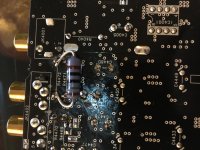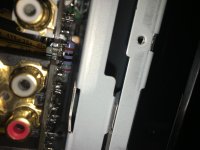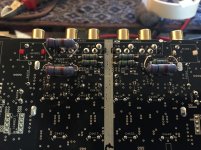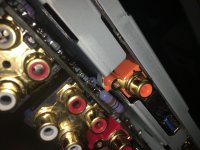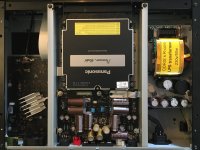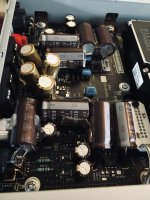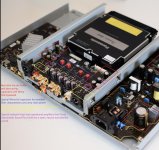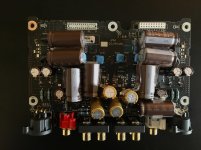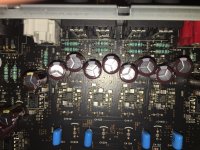After a conversation with Coris, I tried rewiring the mains cable to earth the LPS board. Seems Panasonic don't earth the board to the plug. I have experimented with the earthing before. So I thought I'd give it a go and have the chance to recheck how the LPS compares to the old SMPS.
SMPS vs not main cable earthed LPS
Some quite noticeable differences, whilst the overall sound was very similar in many ways there were some areas of distinct difference in my system
Bass, the SMPS was full but not as weighty, dynamic and solid as the LPS, it sounded softer and less resolving.
There was. greater sense of 'blackness' with the LPS and it sounded easier to listen into the recording, a little more being there than watching. the dynamics were also better with the LPS. Overall resolution was reduced a little with the SMPS and it just lacked the immediacy, dynamic tension of the LPS. Musically the LPS was better as it seems to have a 'flow' that was more analogue and less digital.
I didn't re do the picture comparison because it was really the audio I wanted to compare. But watching the film with the SMPS I was aware it wasn't as good as I expected which could easily be the film, I'll retry tonight and report back.
The initial impression I had of the LPS sounding a little 'glassy' and a hint 'hardness', the only possible negative has all gone. I suspect that the LPS running in (I know Coris will disagree !)
SMPS vs LPS earthed at the board
I run separate manis lines form the main board for each digital item in my system - projector, Bluray player, processor and Lumagen. Which might have an impact and I run Naim amps which I know are sensitive to earthing choices.
In my system running the unit this way has brought clear improvements the gap between the old SMPS and the LPs has increased, particularly with dynamics and bass separating and weight. It sounds a little more 'real' and has a little more 'body' all very good improvements
Playing the same piano piece I am less aware of the slight lack of lower mid weight, I am not sure I would have noticed in this configuration.
I'll report back following playing some of the film I watched last night regarding the picture comparison
Overall very happy (although I still with Panasonic had built the analogue out with seperate DACS and not one multichannel DAC)
SMPS vs not main cable earthed LPS
Some quite noticeable differences, whilst the overall sound was very similar in many ways there were some areas of distinct difference in my system
Bass, the SMPS was full but not as weighty, dynamic and solid as the LPS, it sounded softer and less resolving.
There was. greater sense of 'blackness' with the LPS and it sounded easier to listen into the recording, a little more being there than watching. the dynamics were also better with the LPS. Overall resolution was reduced a little with the SMPS and it just lacked the immediacy, dynamic tension of the LPS. Musically the LPS was better as it seems to have a 'flow' that was more analogue and less digital.
I didn't re do the picture comparison because it was really the audio I wanted to compare. But watching the film with the SMPS I was aware it wasn't as good as I expected which could easily be the film, I'll retry tonight and report back.
The initial impression I had of the LPS sounding a little 'glassy' and a hint 'hardness', the only possible negative has all gone. I suspect that the LPS running in (I know Coris will disagree !)
SMPS vs LPS earthed at the board
I run separate manis lines form the main board for each digital item in my system - projector, Bluray player, processor and Lumagen. Which might have an impact and I run Naim amps which I know are sensitive to earthing choices.
In my system running the unit this way has brought clear improvements the gap between the old SMPS and the LPs has increased, particularly with dynamics and bass separating and weight. It sounds a little more 'real' and has a little more 'body' all very good improvements
Playing the same piano piece I am less aware of the slight lack of lower mid weight, I am not sure I would have noticed in this configuration.
I'll report back following playing some of the film I watched last night regarding the picture comparison
Overall very happy (although I still with Panasonic had built the analogue out with seperate DACS and not one multichannel DAC)
Last edited:
Well, grounding the UP9000 chassis to outlet ground it can be fortunate in your particularly system. The UB9000 it is however grounded, through the cables connected on its outputs, to the further devices in the system (amp, AV receiver, etc.). If the other devices in the system may not be well grounded, or it may have a particularly such connection, then it could be a clue to ground the player chassis.
However, it should be also mentioned another aspect in this regard. With its original SMPS, the UB9000 it have the chassis always tied either to the neutral or to the hot line of the AC outlet power, through a special capacitor (inside its original SMPS). Therefore in such case it is important how the IEC is wired to outlet. If the outlet it not have a neutral, then it start to become problematic a such grounding approach in the existing consumer SMPSes...
When using an LPS this stupidity does not exist. There is no whatsoever connection in between the AC network and the chassis (because the LPS transformer it fully isolate one from another). The device grounding it is in LPS case, very well done by the connection cables, in only one point, through the terminal device (in the system) ground connection. If connecting the chassis to ground (outlet ground), when using an LPS, it may be created an ground loup. A such loup may not affect anything in some cases, but it could have negative impact in other cases, function on how the groundings of the other devices in the system are made. Well, all these things it can be quite complicated in some cases, as well.
The best as principle is not grounding (to outlet ground) the chassis of UB9000, especially when using an LPS. In some cases a such grounding may not bring any whatsoever improvement, or it may have a positive impact in other cases.
So, if it works fine in a certain system, then is all right. But as a rule, this it may not apply in general, in all cases.
However, it should be also mentioned another aspect in this regard. With its original SMPS, the UB9000 it have the chassis always tied either to the neutral or to the hot line of the AC outlet power, through a special capacitor (inside its original SMPS). Therefore in such case it is important how the IEC is wired to outlet. If the outlet it not have a neutral, then it start to become problematic a such grounding approach in the existing consumer SMPSes...
When using an LPS this stupidity does not exist. There is no whatsoever connection in between the AC network and the chassis (because the LPS transformer it fully isolate one from another). The device grounding it is in LPS case, very well done by the connection cables, in only one point, through the terminal device (in the system) ground connection. If connecting the chassis to ground (outlet ground), when using an LPS, it may be created an ground loup. A such loup may not affect anything in some cases, but it could have negative impact in other cases, function on how the groundings of the other devices in the system are made. Well, all these things it can be quite complicated in some cases, as well.
The best as principle is not grounding (to outlet ground) the chassis of UB9000, especially when using an LPS. In some cases a such grounding may not bring any whatsoever improvement, or it may have a positive impact in other cases.
So, if it works fine in a certain system, then is all right. But as a rule, this it may not apply in general, in all cases.
Last edited:
After some time listening to the Takman Rey, I am very impressed the only area I would say they might benefit from is a little more lower mid projection to add weight to voices. These resistors are in series, the signal is going through, so I guess quite critical to the sound. I'm not expecting or wanting a resistor to add anything but to take away fractionally less
I have now fitted some Shinkoh's in combination with the Rey's
A bit more tricky to add Shinkoh's the leads are too broad to fit on the 1W versions, so I have experimented with the centre channel using 300 Ohm Takman Rey and 150 Ohm Shinkoh in combination. If I dont prefer this I will go back to the Rey I took out, if I do I will add to the foot left, right, not a lot of room !
I have now fitted some Shinkoh's in combination with the Rey's
A bit more tricky to add Shinkoh's the leads are too broad to fit on the 1W versions, so I have experimented with the centre channel using 300 Ohm Takman Rey and 150 Ohm Shinkoh in combination. If I dont prefer this I will go back to the Rey I took out, if I do I will add to the foot left, right, not a lot of room !
Attachments
It would be very easy to provide a more accurate assessment of combining the Shinkoh with the Takman in place of just the Takman, however after running in and then simply playing 3-4 test tracks for the first time since altering I hope is accurate enough.
After some 40 years listening to audio I try very hard to be as objective as possible so here goes....
Firstly it seems relatively subtle, but with some very familiar scenes to assess the voice it does seem to be a little fuller in the voice and appears to have a little more naturalness and weight. The tonality is very similar its no brighter or duller, it seems just a little bit more natural and resolving. It would be difficult to assess the very low frequencies as this I only on the centre channel.
At the moment the system is sounding so good I am not rushing to take it apart, I simply want to watch more films 🙂
My next steps is to do the same or similar to the front L, R and see if this supports the initial conclusions.
After some 40 years listening to audio I try very hard to be as objective as possible so here goes....
Firstly it seems relatively subtle, but with some very familiar scenes to assess the voice it does seem to be a little fuller in the voice and appears to have a little more naturalness and weight. The tonality is very similar its no brighter or duller, it seems just a little bit more natural and resolving. It would be difficult to assess the very low frequencies as this I only on the centre channel.
At the moment the system is sounding so good I am not rushing to take it apart, I simply want to watch more films 🙂
My next steps is to do the same or similar to the front L, R and see if this supports the initial conclusions.
The final resistor swap ?
After speaking with Coris I appreciated that the 100 Ohm is not necessarily ideal in my situation (my naim AV2 has pretty high input impedence 47K Ohms) most of the same period Naim CD player and DVD players had 10 Ohm output impedence, so it made sense to reduce the resistance. I dropped to low 20's, so hopefully that will be okay (shortage of shinkoh resistors at higher levels, I was aiming at 30 but couldn't match that easily) I kept the TAKMAN REY 100's in place and added to the back of the board, using shinkohs for L,R,C it would have been super tricky to add the large 1W shinkohs for all 8 channels and they are £12.00 each ! So I didn't want £60 on the shelf if I couldn't squeeze them in
Initial impressions very good indeed, seems weightier and more dynamic and slightly more organic and natural. I'll wait a week to get my test discs out and do a critical listen
I'm not changing these again - hopefully
After speaking with Coris I appreciated that the 100 Ohm is not necessarily ideal in my situation (my naim AV2 has pretty high input impedence 47K Ohms) most of the same period Naim CD player and DVD players had 10 Ohm output impedence, so it made sense to reduce the resistance. I dropped to low 20's, so hopefully that will be okay (shortage of shinkoh resistors at higher levels, I was aiming at 30 but couldn't match that easily) I kept the TAKMAN REY 100's in place and added to the back of the board, using shinkohs for L,R,C it would have been super tricky to add the large 1W shinkohs for all 8 channels and they are £12.00 each ! So I didn't want £60 on the shelf if I couldn't squeeze them in
Initial impressions very good indeed, seems weightier and more dynamic and slightly more organic and natural. I'll wait a week to get my test discs out and do a critical listen
I'm not changing these again - hopefully
Attachments
Interesting the 900 MkII will have a few tweaks
"UB9000 will come back in May 2021, same specifications but new sound processor," said Panasonic. "It will keep the same specifications as before. It is not planned right now to add SACD & DVD-A."
"UB9000 will come back in May 2021, same specifications but new sound processor," said Panasonic. "It will keep the same specifications as before. It is not planned right now to add SACD & DVD-A."
An update own the Shinkoh's
After dropping the impedance to 21 Ohms and fitting Shinkoh's in combination with the Takmans I am very pleased to say it has taken things a little further. The dynamics and sense of scale has improved marginally and the tonal density and body/weight has improved the voices in particular are now very good indeed. The sound seems more realistic and very natural, the resolution and detail is also excellent without being forward or exaggerated.
I'd liken the Shinkoh combination to a feeling of just less restriction and a more natural tone to everything coming through. Zero hardness or glare yet plenty of projection and dynamics.
I can see why people rate the Shinkoh's very highly, they somehow make the other resistors seem a little restricted and tonally limited
After dropping the impedance to 21 Ohms and fitting Shinkoh's in combination with the Takmans I am very pleased to say it has taken things a little further. The dynamics and sense of scale has improved marginally and the tonal density and body/weight has improved the voices in particular are now very good indeed. The sound seems more realistic and very natural, the resolution and detail is also excellent without being forward or exaggerated.
I'd liken the Shinkoh combination to a feeling of just less restriction and a more natural tone to everything coming through. Zero hardness or glare yet plenty of projection and dynamics.
I can see why people rate the Shinkoh's very highly, they somehow make the other resistors seem a little restricted and tonally limited
Coris, hi
Can you share the definition of the two sets of output connectors of the power module?
Can you share the definition of the two sets of output connectors of the power module?
After finalising the resistor choice I am now experimenting a little with the AC coupling caps, I have swapped out the Nichicon fine golds for Silmic II's on the L,R,C and Sub channel for the multichannel coupling caps - 470uf 35V. it would be very difficult if not impossible to do this for all channels but interesting to compare Nichicon Fine Golds to Silmcs in this position
I have also added some self adhesive mounting tape to dampen them and hold secure
I'll put a few hours on them and report back
I have also added some self adhesive mounting tape to dampen them and hold secure
I'll put a few hours on them and report back
Attachments
Last edited:
Really pleased with the results after 80 or so hours, I know there has been a lot written about burn in and these caps are suppose to need 80-100 hours my notes after the first switch on, then at 50 hours and now with 80
First on they sounded very good, slightly more dynamic more body and weight and substance, particularly in the lower mids, good clarity but perhaps not as resolving as the Fine Golds, slightly less physical scale good tonality and quite organic and real sounding. The first films sounded good and very analogue but somehow a little dark and possibly a little rolled off in the higher registers.
Then a familiar test disc at 40-50 hours, they were stronger in the bass possibly a little bloated and softer and also a little muffles and dull, a few parts of the upper mids, on piano and some vocals sounded dull and recessed.Tonally nice and pretty good overall but lacking the resolution. I like the tonality but they lacked the space and projection from the lower mids up. Also they did sound a little bloated in the bass, I took 1 db out as it was a little too heavy. At this point I wanted some of what they had bought to the sounds - complete lack of glare very good tonality and realism to things, but desperately wanted the missing resolution and projection in the higher frequencies. If they had stayed this way the Fine Golds were the winner and would be going back in
Afte 80 hours they took on a step change, all of the upper mid and high end is back, they are not forward but sound every bit as resolving as the fine Golds but with more body and tonal density everywhere, slightly more dynamics and weight in the bass and a great sense if ease and clarity. Now I would say the Fine Golds sound slightly more 'polite' and reserved than the Silmics and also slightly leaner and thinner in the upper mid. vocals now have superb projection, body and clarity, very in the room and real texture to things
I have to say this is the best sounds I have had at home in the cinema set up a notable step forward from the Acurus ACT4 now, from memory everywhere not just in the tonality and musical flow.
These are not expensive caps, physically large, shame more manufacturers don't spec them
First on they sounded very good, slightly more dynamic more body and weight and substance, particularly in the lower mids, good clarity but perhaps not as resolving as the Fine Golds, slightly less physical scale good tonality and quite organic and real sounding. The first films sounded good and very analogue but somehow a little dark and possibly a little rolled off in the higher registers.
Then a familiar test disc at 40-50 hours, they were stronger in the bass possibly a little bloated and softer and also a little muffles and dull, a few parts of the upper mids, on piano and some vocals sounded dull and recessed.Tonally nice and pretty good overall but lacking the resolution. I like the tonality but they lacked the space and projection from the lower mids up. Also they did sound a little bloated in the bass, I took 1 db out as it was a little too heavy. At this point I wanted some of what they had bought to the sounds - complete lack of glare very good tonality and realism to things, but desperately wanted the missing resolution and projection in the higher frequencies. If they had stayed this way the Fine Golds were the winner and would be going back in
Afte 80 hours they took on a step change, all of the upper mid and high end is back, they are not forward but sound every bit as resolving as the fine Golds but with more body and tonal density everywhere, slightly more dynamics and weight in the bass and a great sense if ease and clarity. Now I would say the Fine Golds sound slightly more 'polite' and reserved than the Silmics and also slightly leaner and thinner in the upper mid. vocals now have superb projection, body and clarity, very in the room and real texture to things
I have to say this is the best sounds I have had at home in the cinema set up a notable step forward from the Acurus ACT4 now, from memory everywhere not just in the tonality and musical flow.
These are not expensive caps, physically large, shame more manufacturers don't spec them
The ESS DAC chips it should provide better quality than all what it was before, but the right implementation of these devices it suffered enough by the stupid ESS secrecy policy, or the limited informations provided by the producer to those who intended the use of their products (I mean here not about privat entusiasts, but about big manufacturers). Just think about: a manufacturer it launch on marked a superior product, but it provide limited informations about important functional details, because it is afraid for concept stealing... or concept copying, or whatever...
Well, in the last time (after many years of secrecy policy), it seems ESS realised that such attitude is not very productive for their business, and renounced to their secrecy concept (not full renouncing also, as their datasheets it still missing some important details, or even it still include intentional/uncorrected errors).
ESS DAC chips it should sounds better, but the implementations concepts are many and always not very fortunate, depending on how particular designers have appreciated the available functional informations provided by ESS.
Personally, I am still be very satisfied with Burr Brown chips (PCM family), which in my opinion and taste, it can sounds a lot better than ESS chips (in particular implementations), even these delta/sigma DAC devices are quite old now... "The good old things", you know...
Panasonic it have initially designed the digital board, based on an ESS DAC chip, but for some reasons it added also on board, and actually populated it with AKM chips. Now, regarding the issuing of the upgraded 9000 version, they decided for some reasons to populate the original designed digital board with ESS DAC chips. It may be a step forward, but it will sounds better?
With the right design corrections and improvements, the AKM DAC chips on board (old version UB9000), it sounds very well indeed. It is the same as for Oppo 203 (original audio board/section)...
Well, in the last time (after many years of secrecy policy), it seems ESS realised that such attitude is not very productive for their business, and renounced to their secrecy concept (not full renouncing also, as their datasheets it still missing some important details, or even it still include intentional/uncorrected errors).
ESS DAC chips it should sounds better, but the implementations concepts are many and always not very fortunate, depending on how particular designers have appreciated the available functional informations provided by ESS.
Personally, I am still be very satisfied with Burr Brown chips (PCM family), which in my opinion and taste, it can sounds a lot better than ESS chips (in particular implementations), even these delta/sigma DAC devices are quite old now... "The good old things", you know...
Panasonic it have initially designed the digital board, based on an ESS DAC chip, but for some reasons it added also on board, and actually populated it with AKM chips. Now, regarding the issuing of the upgraded 9000 version, they decided for some reasons to populate the original designed digital board with ESS DAC chips. It may be a step forward, but it will sounds better?
With the right design corrections and improvements, the AKM DAC chips on board (old version UB9000), it sounds very well indeed. It is the same as for Oppo 203 (original audio board/section)...
Last edited:
Finally, after two years, Panasonic have succeeded in releasing a new firmware update for UB9000 (v1.69). My enjoyment for this event it was very short... There are updated something about new disks formats/compatibility and so. For the whole rest, nothing. Exactly the same old annoying issues are continuing after update as well. The device it further stop functioning (it freeze it up) in some circumstances while using network services. In some situations, the video signal is just gone, and a reset is necessary to get back to the normal functioning. In the last time, I have registered also white noise outputted on HDMI for both sound and video, while power off sequence (the HDMI port is not muted correctly for this sequence).
The acute Panasonic arrogance and respect less for the buyers of their product, it seems to continue... At least in this case of this player... So bad!
The acute Panasonic arrogance and respect less for the buyers of their product, it seems to continue... At least in this case of this player... So bad!
Anyone try the new ESS chip ?
Glad this thread is still alive !
I have been thoroughly enjoying the 9000 and have considered trying a Revon 200, just to see how it fares in comparison to a modified 9000 (not as good I suspect, but some reviews are quite positive)
Glad this thread is still alive !
I have been thoroughly enjoying the 9000 and have considered trying a Revon 200, just to see how it fares in comparison to a modified 9000 (not as good I suspect, but some reviews are quite positive)
Finally, after two years, Panasonic have succeeded in releasing a new firmware update for UB9000 (v1.69). My enjoyment for this event it was very short... There are updated something about new disks formats/compatibility and so. For the whole rest, nothing. Exactly the same old annoying issues are continuing after update as well. The device it further stop functioning (it freeze it up) in some circumstances while using network services. In some situations, the video signal is just gone, and a reset is necessary to get back to the normal functioning. In the last time, I have registered also white noise outputted on HDMI for both sound and video, while power off sequence (the HDMI port is not muted correctly for this sequence).
The acute Panasonic arrogance and respect less for the buyers of their product, it seems to continue... At least in this case of this player... So bad!
Totally agree Coris.Even after lots of request Panasonic still ignore the 20 mins power off setting.Yet now found info that the quick start setting consumes more power than keeping the player running with disc stopped but system not turned off.Last Panasonic item i will ever buy.
Well, what is positive with this device, is a better picture, and an more evolved hardware system. Unfortunately, this good hardware system it suffer further by the unfinished design of the software/firmware. It seems that Panasonic have written the device firmware, so that a minimal functionality and a minimal user friendly should be achieved. This for sure for costs reasons. And ignoring the product buyers needs or customers confort in using this product.
Indeed, the auto turn of (standby) of this device is highly annoying. No option for the user to modify this function. No information about this function is provided by Panasonic, so for the eventual buyers of the product being known with it before buying the device. Then the only user choice is to accept it.
Because poor design of the firmware, and Panasonic lack of interest in correcting the design faults, a such stand by function it introduce even more faults in system functionality. The device it not store correctly all parameters before going into standby, and after waking up, issues it occur. The player start up with a general reset is the optimal solution, so as the Oppo have done for their products.
Indeed, the auto turn of (standby) of this device is highly annoying. No option for the user to modify this function. No information about this function is provided by Panasonic, so for the eventual buyers of the product being known with it before buying the device. Then the only user choice is to accept it.
Because poor design of the firmware, and Panasonic lack of interest in correcting the design faults, a such stand by function it introduce even more faults in system functionality. The device it not store correctly all parameters before going into standby, and after waking up, issues it occur. The player start up with a general reset is the optimal solution, so as the Oppo have done for their products.
I would like repopulating the caps which are missing on board (beside the blue caps or the Wima ones in this picture - central area). It was designed to be there, but Panasonic wanted to reduce the production costs... Some 1000µ - 2000µ/16v will be good...
By the way, the original blue it are very good film caps, and is not necessary replacing it with other ones.
By the way, the original blue it are very good film caps, and is not necessary replacing it with other ones.
Last edited:
Yes, is that I was meaning about, but it seems to me, it may not be very much place available on your modified board... I cannot see very well in your picture, but if you have already used 4700µ on opamps +/- power rails, it may not be necessary adding another caps where are missing. If you used 470µ, then it may be necessary. 16v rated caps are just fine for these positions. As the caps have higher voltage rating, their physical dimensions become larger as well...
- Home
- Source & Line
- Digital Source
- Panasonic UB9000 - discussions, mods, improvements
